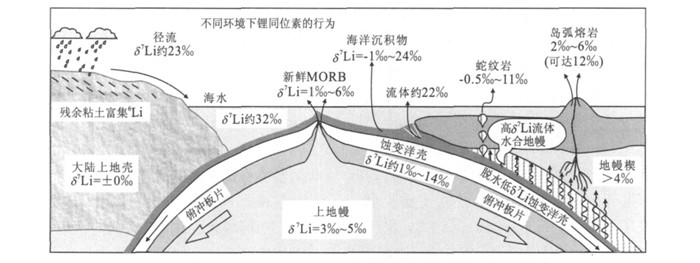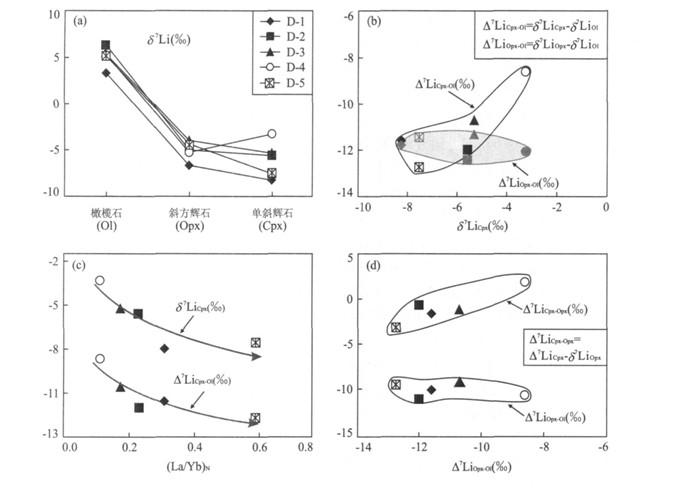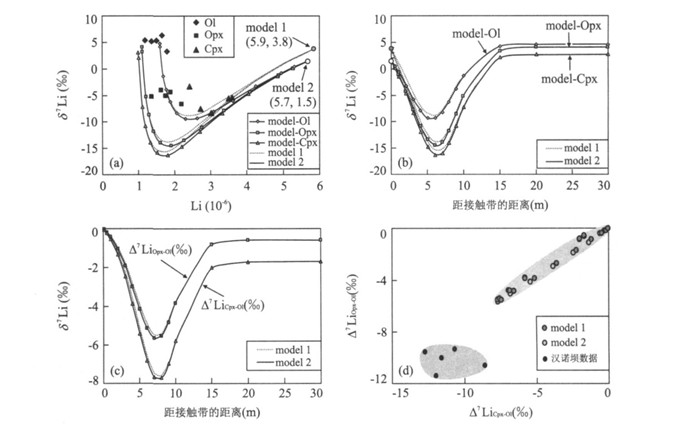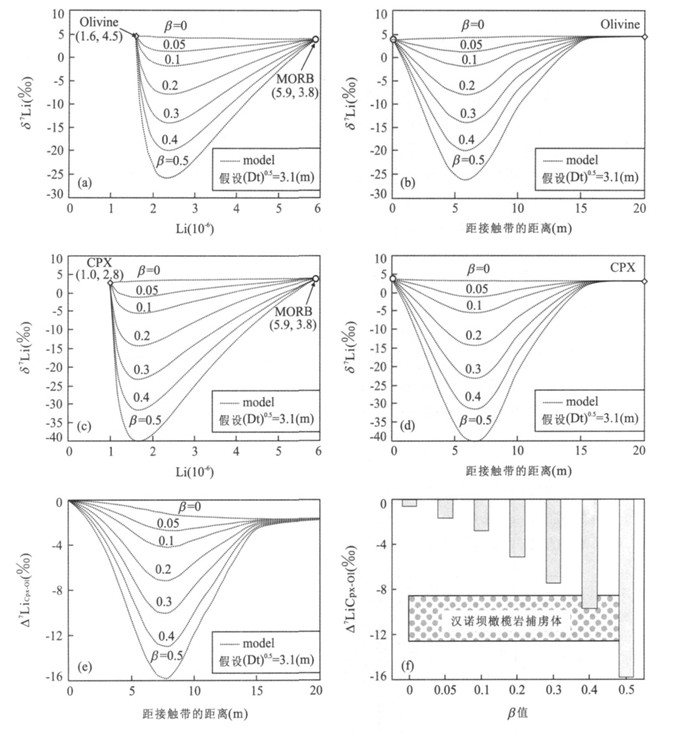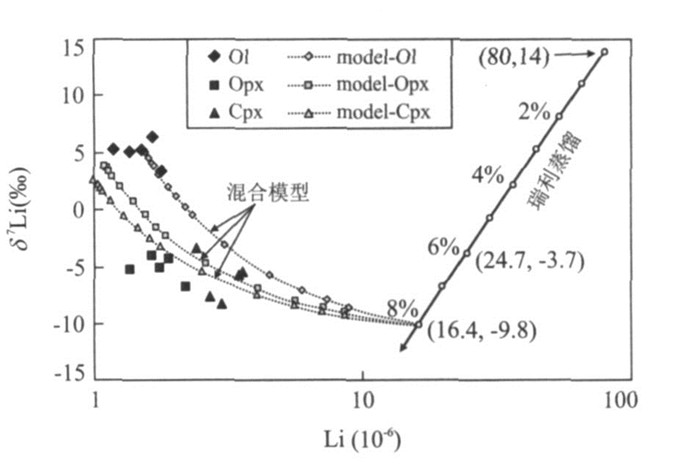Discussion on Fractionation Mechanism of Lithium Isotopes
-
摘要: 作为一种新兴的稳定同位素示踪工具, 锂同位素地球化学的研究近年来受到了国际地学界日益广泛的关注.其应用领域涵盖了从地表到地幔的流体与矿物之间的相互作用.在地表风化作用过程中, 轻锂同位素(6Li) 优先进入固体相, 而7Li则进入流体相, 因而地表风化作用淋滤出了岩石中的重锂, 致使河水具有重的锂同位素组成, 河水又将重锂同位素组分补给海洋, 洋壳的低温蚀变作用使得海水的锂同位素组成进一步变重.在俯冲带, 由于俯冲板片释放的流体具有重锂同位素组成的特征, 它们上升并交代上覆的地幔楔和相邻的地幔, 使得地幔楔的锂同位素组成变重.同时, 深俯冲的板片由于脱水而具有较轻的锂同位素组成, 它们在地幔中可能形成一个局部轻锂的地幔储源.影响地幔橄榄岩锂同位素分馏的因素主要有3个方面: 温度、扩散机制以及外来熔体的反应.由于高温下地幔矿物之间的锂同位素分馏很小, 而单纯的扩散分馏机制不能够很好的解释我国华北汉诺坝地区地幔橄榄岩中矿物之间的锂同位素分馏.因此, 具有轻锂同位素组成的熔体与橄榄岩之间的反应是上述现象的一个合理解释.需要指出的是, 在橄榄岩-熔体反应的过程中, 锂同位素的扩散作用也对地幔矿物之间的同位素分馏有一定的贡献.Abstract: As a burgeoning tracer of stable isotopes, lithium geochemistry has attracted increasing attention from the international geological community recently.Its application field covers the interactions between fluids and minerals from the surface to the mantle.During weathering, the lighter isotope 6Li is preferentially retained in the solid phase while 7Li goes into solution.Thus river waters have heavy Li isotopic compositions compared to the original bedrock.The heavy Li isotopic compositions of river water feed the oceans.Low-temperature alteration of oceanic crust then makes seawater heavier than river water.In a subduction zone, heavy Li of fluids escaping the slab at low temperature likely enrich the forearc mantle wedge and hydrate the adjacent mantle and make them isotopically heavier than before.Meanwhile, an isotopically light component of slab dehydrated is subducted deeply and may form a locally light-Li mantle reservoir.There are three main factors that can result Li isotopic fractionation in mantle peridotites.They are temperature, diffusion-driven fractionation and mixing with exotic melts.At high temperatures of magmatic processes, Li isotopes do not show per mil-level mass fractionation, and simple diffusive process can not account for the Li isotopic fractionation between the minerals in peridotitic xenoliths from the Hannuoba area in the North China Craton, thus the reaction between peridotites and melts with light Li isotopic compositions maybe a reasonable explanation.It should point out that diffusion of Li isotopes during peridotite-melt reaction makes some contributions to the isotopic fractionation between the mantle minerals.
-
Key words:
- Li isotopes /
- fractionation mechanism /
- geochemical tracer
-
图 1 不同储源的锂同位素组成
数据来源: 海水(You and Chan, 1996; Chan and Edmond, 1988; Moriguti and Nakamura, 1998b; Tomascak et al., 1999b; James and Palmer, 2000); 河水(Huh et al., 1998); 高温孔隙流体(Foustoukos et al., 2004; Kisakürek et al., 2004); 岛弧熔岩(Moriguti and Nakamura, 1998a; Tomascak et al., 2000, 2002; Chan et al., 2002b); 洋岛玄武岩(Tomascak et al., 1999b; Chan and Frey, 2003); 新鲜玄武岩(Chan et al., 1992, 2002b; Moriguti and Nakamura, 1998a; Tomascak and Langmuir, 1999); 蚀变玄武岩(Chan et al., 1992, 2002a); 海洋沉积物(Chan et al., 1994a; Zhang et al., 1998; James et al., 1999; Chan and Kastner, 2000); 黄土、页岩和大陆上地壳(Teng et al., 2004); 榴辉岩(Zack et al., 2003; Marschall et al., 2007); 橄榄岩和辉石岩捕虏体(Tang et al., 2007b); 其他数据来源(Tomascak, 2004)
Fig. 1. Li isotopic composition of different reservoirs
图 2 锂同位素的地球化学行为示意图(据Tang et al., 2007b修改)
地表风化作用使得河水具有高的7Li, 河水将高7Li组分补给海洋, 低温洋底蚀变作用使海水的锂同位素组成进一步变重.来自俯冲板片的流体及蛇纹岩底辟块(均高δ7Li) 的重锂同位素特征说明在蚀变洋壳脱水过程中发生了锂同位素分馏.由于俯冲板片释放的流体具有高δ7Li的特征, 它们上升并交代上覆地幔楔, 从而使地幔楔具有重的锂同位素组成.因此, 一些岛弧熔岩具有高δ7Li的特征
Fig. 2. Schematic illustration of Li isotope geochemical behaviors
图 3 橄榄石、单斜辉石和斜方辉石中δ7Li的变化(a), Δ7LiCpx-Ol和Δ7LiOpx-Ol随δ7LiCpx的变化(b), δ7LiCpx和Δ7LiCpx-Ol随单斜辉石的(La/Yb) N的变化(c), δ7LiOpx-Ol和Δ7LiCpx-Opx随Δ7LiCpx-Ol的变化(d)
图(a) 和数据来自Tang et al. (2007a)
Fig. 3. Plots showing the variations in δ7Li between olivine, Cpx, and Opx (a), Δ7LiCpx-Ol and Δ7LiOpx-Ol versus δ7LiCpx (b), δ7LiCpx and Δ7LiCpx-Ol versus (La/Yb) N ratios in Cpx (c), and δ7LiOpx-Ol and Δ7LiCpx-Opx versus Δ7LiCpx-Ol (d)
图 4 扩散模型计算结果(model曲线) 与汉诺坝橄榄岩中矿物Li-δ7Li的对比(a), 橄榄石、斜方辉石和单斜辉石的δ7Li随扩散距离的变化(b), 模拟计算的Δ7LiCpx-Ol和Δ7LiOpx-Ol随扩散距离的变化(c), 计算结果与实测的Δ7LiCpx-Ol和Δ7LiOpx-Ol的对比(d)
Model 1和model 2分别代表两种不同组成的熔体, 它们代表MORB的变化范围(Moriguti and Nakamura, 1998a).计算参数见表 1
Fig. 4. Diffusion model calculations (model curves) compared to data for Li andδ7Li of minerals in Hannuoba peridotites (a), δ7Li of Ol, Opx and Cpx versus distance from the contact for melt diffusion model (b), Δ7LiCpx-Ol and Δ7LiOpx-Ol versus distance from the contact (c), and Δ7LiCpx-Ol versus Δ7LiOpx-Ol in the diffusion calculations compared to data measured (c)
图 6 汉诺坝橄榄岩中矿物的锂含量和同位素组成以及瑞利蒸馏和同位素二端元混合模型
图中的百分数表示蚀变洋壳脱水的百分比.二端元混合模型参数: 端元1 (熔体) 锂含量为11.5×10-6, δ7Li=-15‰, 端元2 (矿物) 与图 4相同
Fig. 6. Diagram of Li versus δ7Li for minerals in Hannuoba peridotites, and Rayleigh distillation model and two end-member mixing model
表 1 扩散模型计算所采用的参数
Table 1. Parameters used in diffusion model

-
Benton, L. D., Ryan, J. G., Savov, I. P., 2004. Lithiumabun-dance and isotope systematics of forearc serpentinites, Conical Seamount, Mariana forearc: Insights into themechanics of slab-mantle exchange during subduction. Geochemistry Geophysics Geosystems, 5: doi: 10.1029/2004GC000708. Bouman, C., Elliott, T., Vroon, P. Z., 2004. Lithiuminputsto subduction zones. Chem. Geol., 212: 59-79. doi: 10.1016/j.chemgeo.2004.08.004 Brenan, J. M., Neroda, E., Lundstrom, C. C., et al., 1998a. Behaviour of boron, beryllium and lithium during melt-ing and crystallization: Constraints from mineral-meltpartitioning experiments. Geochim. Cosmochim. Acta, 62: 2129-2141. doi: 10.1016/S0016-7037(98)00131-8 Brenan, J. M., Ryerson, F. J., Shaw, H. F., 1998b. The roleof aqueous fluids in the slab-to-mantle transfer of bo-ron, beryllium, and lithium during subduction: Experi-ments and models. Geochim. Cosmochim. Acta, 62: 3337-3347. doi: 10.1016/S0016-7037(98)00224-5 Chan, L. H., 1987. Lithiumisotope analysis by thermal ioni-zation mass spectrometry of lithiumtetraborate. Anal. Chem., 59: 2662-2665. doi: 10.1021/ac00149a007 Chan, L. H., Alt, J. C., Teagle, D. A. H., 2002a. Lithiumandlithium isotope profiles through the upper oceaniccrust: Astudy of seawater-basalt exchange at ODP Sites504B and896A. Earth Planet. Sci. Lett. , 201: 187-201. doi: 10.1016/S0012-821X(02)00707-0 Chan, L. H., Edmond, J. M., 1988. Variation of lithium isotope composition in the marine environment: A preliminaryreport. Geochim. Cosmochim. Acta, 52: 1711-1717. doi: 10.1016/0016-7037(88)90239-6 Chan, L. H., Edmond, J. M., Thompson, G., 1993. A lithiumisotope study of hot-springs and metabasalts from midoceanridge hydrothermal systems. Journal of GeophysicalResearch (Solid Earth), 98 (B6): 9653-9659. doi: 10.1029/92JB00840 Chan, L. H., Edmond, J. M., Thompson, G., et al., 1992. Lithium isotopic composition of submarine basalts: Implications for the lithium cycle in the oceans. EarthPlanet. Sci. Lett., 108 (1-3): 151-160. doi: 10.1016/0012-821X(92)90067-6 Chan, L. H., Frey, F. A., 2003. Lithiumisotope geochemis-try of the Hawaiian plume: Results from the HawaiiScientific Drilling Project and Koolau volcano. Geochem. Geophys. Geosyst., 4 (3): doi: 10.1029/2002GC000365. Chan, L. H., Gieskes, J. M., You, C. F., et al., 1994a. Lithi-umisotope geochemistry of sediments and hydrothermalfluids of the Guaymas basin, Gulf of California. Geochim. Cosmochim. Acta, 58 (20): 4443-4454. doi: 10.1016/0016-7037(94)90346-8 Chan, L. H., Gieskes, J. M., You, C. F., et al., 1994b. Lithi-umisotope geochemistry of sediments and hydrothermalfluids of the Guaymas basin, Gulf of California. Geochim. Cosmochim. Acta, 58: 4443-4454. doi: 10.1016/0016-7037(94)90346-8 Chan, L. H., Kastner, M., 2000. Lithiumisotopic composi-tions of pore fluids and sediments inthe Costa Rica sub-duction zone: Implications for fluid processes and sedi-ment contribution to the arc volcanoes. Earth Planet. Sci. Lett., 183: 275-290. doi: 10.1016/S0012-821X(00)00275-2 Chan, L. H., Leeman, W. P., You, C. F., 2002b. Lithiumiso-topic composition of Central American volcanic arc la-vas: Implications for modification of subarc mantle byslab-derived fluids: Correction. Chem. Geol., 182: 293-300. doi: 10.1016/S0009-2541(01)00298-4 Chaussidon, M., Robert, F., 1998. 7Li/6Li and11B/10B varia-tions in chondrules fromthe Semarkona unequilibrated chondrite. Earth Planet. Sci. Lett., 164: 577-589. doi: 10.1016/S0012-821X(98)00250-7 Coogan, L. A., Kasemann, S. A., Chakraborty, S., 2005. Rates of hydrothermal cooling of new oceanic uppercrust derived from lithium-geospeedometry. EarthPlanet. Sci. Lett., 240: 415-424. doi: 10.1016/j.epsl.2005.09.020 Crank, J., 1975. The mathematics of diffusion. ClarendonPress, Oxford, 1-414. Decitre, S., Deloule, E., Reisberg, L., et al., 2002. Behaviourof Li and its isotope during serpentinization of oceanicperidotites. Geochem. Geophys. Geosyst., 3 (1): doi: 10.1029/2001GC000187. Elliott, T., Jeffcoate, A., Bouman, C., 2004. The terrestrialLi isotope cycle: Light-weight constrains on mantle con-vection. Earth Planet. Sci. Lett., 220: 231-245. doi: 10.1016/S0012-821X(04)00096-2 Elliott, T., Thomas, A., Jeffcoate, A., et al., 2006. Lithiumiso-tope evidence for subduction-enriched mantle in the sourceof mid-ocean-ridge basalts. Nature, 443: 565-568. doi: 10.1038/nature05144 Flesch, G. D., Anderson Jr., A. R., Svec, H. J., 1973. Asec-ondaryisotopic standard for6Li/7Li determinations. In-ternational Journal of Mass Spectrumetry and IonProcesses, 12 (3): 265-272. Foustoukos, D. I., James, R. H., Berndt, M. E., et al., 2004. Lithiumisotopic systematics of hydrothermal vent flu-ids at the Main Endeavour Field, Northern Juan de FucaRidge. Chem. Geol., 212 (1-2): 17-26. doi: 10.1016/j.chemgeo.2004.08.003 Hoefs, J., Sywall, M., 1997. Lithiumisotope composition ofQuaternary and Tertiary biogene carbonates and a glob-al lithiumisotope balance. Geochim. Cosmochim. Acta, 61: 2679-2690. doi: 10.1016/S0016-7037(97)00101-4 Huh, Y., Chan, L. H., Edmond, J. M., 2001. Lithium iso-topes as a probe of weathering processes: Orinoco river. Earth Planet. Sci. Lett., 194: 189-199. doi: 10.1016/S0012-821X(01)00523-4 Huh, Y., Chan, L. H., Zhang, L., et al., 1998. Lithium andits isotopes in major world rivers: Implications forweathering and the oceanic budget. Geochim. Cosmo-chim. Acta, 62 (12): 2039-2051. doi: 10.1016/S0016-7037(98)00126-4 Jambon, A., 1980. Isotopic fractionation: A kinetic model forcrystals growing from magmatic melts. Geochim. Cos-mochim. Acta, 44 (9): 1373-1380. doi: 10.1016/0016-7037(80)90096-4 James, R. H., Pal mer, M. R., 2000. The lithiumisotope com-position of international rock standards. Chem. Geol., 166: 319-326. doi: 10.1016/S0009-2541(99)00217-X James, R. H., Rudnicki, M. D., Pal mer, M. R., 1999. The al-kali element and boron geochemistry of the Escanabatrough sediment-hosted hydrothermal system. EarthPlanet. Sci. Lett., 171 (1): 157-169. doi: 10.1016/S0012-821X(99)00140-5 Jeffcoate, A. B., Elliott, T., Kasemann, S. A., et al., 2007. Liisotope fractionation in peridotites and mafic melts. Geochim. Cosmochim. Acta, 71 (1): 202-218. doi: 10.1016/j.gca.2006.06.1611 Kerrick, D. M., Connolly, J. A. D., 2001a. Metamorphic devolatilization of subducted marine sediment and thetransport of volatiles into the earth's mantle. Nature, 411: 293-296. doi: 10.1038/35077056 Kerrick, D. M., Connolly, J. A. D., 2001b. Metamorphic devolatilization of subducted oceanic metabasalts: Impli-cations for seismicity, arc magmatismand volatile recy-cling. Earth Planet. Sci. Lett., 189 (1-2): 19-29. doi: 10.1016/S0012-821X(01)00347-8 Kisakürek, B., Widdowson, M., James, R. H., 2004. Behav-iour of Li isotopes during continental weathering: TheBidar laterite profile, India. Chem. Geol., 212 (1-2): 27-44. doi: 10.1016/j.chemgeo.2004.08.027 Kobayashi, K., Tanaka, R., Moriguti, T., et al., 2004. Lithi-um, boron, and lead isotope systematics of glass inclu-sions in olivines from Hawaiian lavas: Evidence for re-cycled components in the Hawaiian plume. Chem. Ge-ol., 212 (1-2): 143-161. doi: 10.1016/j.chemgeo.2004.08.050 Kosler, J., Kucera, M., Sylvester, P., 2001. Precise measure-ment of Li isotope in planktonic foraminiferal tests byquadrapole ICPMS. Chem. Geol., 181: 169-179. doi: 10.1016/S0009-2541(01)00280-7 Li, Y. H., 1982. A brief discussion on the mean oceanic resi-dence time of elements. Geochim. Cosmochim. Acta, 46: 2671-2675. doi: 10.1016/0016-7037(82)90386-6 Lundstrom, C. C., Chaussidon, M., Hsui, A. T., et al., 2005. Observations of Li isotopic variations inthe Trini-ty ophiolite: Evidence for isotopic fractionation by diffu-sion during mantle melting. Geochim. Cosmochim. Acta, 69: 735-751. doi: 10.1016/j.gca.2004.08.004 Magna, T., Wiechert, U., Grove, T. L., et al., 2006. Lithiumisotope fractionation in the southern Cascadia subductionzone. Earth Planet. Sci. Lett., 250 (3-4): 428-443. doi: 10.1016/j.epsl.2006.08.019 Marriott, C. S., Henderson, G. M., Belshaw, N. S., et al., 2004a. Temperature dependence on δ7Li, δ44Ca and Li/Ca incorporation into calciumcarbonate. Earth Planet. Sci. Lett., 222: 615-624. doi: 10.1016/j.epsl.2004.02.031 Marriott, C. S., Henderson, G. M., Crompton, R., et al., 2004b. Effect of mineralogy, salinity, and temperatureon Li/Ca and Li isotope composition of calciumcarbon-ate. Chem. Geol., 212 (1-2): 5-15. doi: 10.1016/j.chemgeo.2004.08.002 Marschall, H. R., Pogge von Strandmann, P. A. E., Seitz, H. M., et al., 2007. The lithiumisotopic composition of o-rogenic eclogites and deep subducted slabs. Earth Plan-et. Sci. Lett., 262 (3-4): 563-580. doi: 10.1016/j.epsl.2007.08.005 Moriguti, T., Nakamura, E., 1998a. Across-arc variation ofLi isotopes in lavas and implications for crust/mantlerecycling at subduction zones. Earth Planet. Sci. Lett., 163 (1-4): 167-174. doi: 10.1016/S0012-821X(98)00184-8 Moriguti, T., Nakamura, E., 1998b. High-yield lithiumsepa-ration and the precise isotopic analysis for natural rockand aqueous samples. Chem. Geol., 145 (1-2): 91-104. doi: 10.1016/S0009-2541(97)00163-0 Moriguti, T., Shibata, T., Nakamura, E., 2004. Lithium, bo-ron and lead isotope and trace element systematics ofQuaternary basaltic volcanic rocks in northeastern Ja-pan: Mineralogical controls on slab-derived fluid compo-sition. Chem. Geol., 212 (1-2): 81-100. doi: 10.1016/j.chemgeo.2004.08.005 Mungall, J. E., 2002. Empirical models relating viscosity andtracer diffusion in magmatic silicate melts. Geochim. Cosmochim. Acta, 66 (1): 125-143. doi: 10.1016/S0016-7037(01)00736-0 Nishio, Y., Shun'ichi, N., Yamamoto, J., et al., 2004. Lithi-umisotopic systematics of the mantle-derived ultramaficxenoliths: Implications for EM1origin. Earth Planet. Sci. Lett., 217 (3-4): 245-261. doi: 10.1016/S0012-821X(03)00606-X Parkinson, I. J., Hammond, S. J., James, R. H., et al., 2007. High-temperautre lithiumisotope fractionation: Insightsfrom lithium isotope diffusion in magmatic systems. Earth Planet. Sci. Lett., 257: 609-621. doi: 10.1016/j.epsl.2007.03.023 Pistiner, J. S., Henderson, G. M., 2003. Lithium-isotope fractionation during continental weathering processes. Earth Planet. Sci. Lett., 214 (1-2): 327-339. doi: 10.1016/S0012-821X(03)00348-0 Raymo, M. E., Ruddiman, W. F., Froelich, P. N., 1988. In-fluence of Late Cenozoic mountain building on ocean ge-ochemical cycles. Geology, 16 (7): 649-653. doi: 10.1130/0091-7613(1988)016<0649:IOLCMB>2.3.CO;2 Richter, F. M., Davis, A. M., Depaolo, D. J., et al., 2003. Isotope fractionation by chemical diffusion betweenmolten basalts and rhyolite. Geochim. Cosmochim. Acta, 67 (20): 3905-3923. doi: 10.1016/S0016-7037(03)00174-1 Richter, F. M., Liang, Y., Davis, A. M., 1999. Isotope frac-tionation by diffusion in molten oxides. Geochim. Cos-mochim. Acta, 63 (18): 2853-2861. doi: 10.1016/S0016-7037(99)00164-7 Rudnick, R. L., Ionov, D. A., 2007. Lithium elemental andisotopic disequilibriumin minerals fromperidotite xeno-liths fromfar-east Russia: Product of recent melt/fluid-rock reaction. Earth Planet. Sci. Lett., 256 (1-2): 278-293. doi: 10.1016/j.epsl.2007.01.035 Rudnick, R. L., Tomascak, P. B., Njo, H. B., et al., 2004. Extreme lithiumisotopic fractionation during continen-tal weathering revealed in saprolites from South Caro-lina. Chem. Geol., 212 (1-2): 45-57. doi: 10.1016/j.chemgeo.2004.08.008 Ryan, J. G., Benton, L. D., Savov, I., 2001. Isotopic and ele-mental signatures of the forearc andimpacts on subduc-tion recycling: Evidence from the Marianas. EOS, 82: V11B-11. Ryan, J. G., Kyle, P. R., 2004. Lithium abundance and lithi-umisotope variations in mantle sources: Insights fromintraplate volcanic rocks from Ross Island and MarieByrd Land (Antarctica) and other oceanic islands. Chem. Geol., 212 (1-2): 125-142. doi: 10.1016/j.chemgeo.2004.08.006 Ryan, J. G., Langmuir, C. H., 1987. The systematics of lithi-umabundances in young volcanic rocks. Geochim. Cos-mochim. Acta, 51 (6): 1727-1741. doi: 10.1016/0016-7037(87)90351-6 Seitz, H. M., Brey, G. P., Lahaye, Y., et al., 2004. Lithiumisotopic signatures of peridotite xenoliths and isotopic fractionation at high temperature between olivine andpyroxenes. Chem. Geol., 212 (1-2): 163-177. doi: 10.1016/j.chemgeo.2004.08.009 Seitz, H. M., Brey, G. P., Weyer, S., et al., 2006. Lithiumisotope compositions of Martian and Lunar reservoirs. Earth Planet. Sci. Lett., 245 (1-2): 6-18. doi: 10.1016/j.epsl.2006.03.007 Seitz, H. M., Woodland, A. B., 2000. The distribution oflithium in peridotitic and pyroxenitic mantle litholo-gies—An indicator of magmatic and metasomatic processes. Chem. Geol., 166 (1-2): 47-64. doi: 10.1016/S0009-2541(99)00184-9 Seyfried Jr., W. E., Chen, X., Chan, L. H., 1998. Trace ele-ment mobility and lithiumisotope exchange during hy-drothermal alteration of seafloor weathered basalts: Anexperimental study at350℃, 500bars. Geochim. Cos-mochim. Acta, 62 (6): 949-960. doi: 10.1016/S0016-7037(98)00045-3 Tang, Y. J., Zhang, H. F., Nakamura, E., et al., 2007a. Lithiumisotopic systematics of peridotite xenoliths from Hannuoba, North China Craton: Implications for melt-rock interactionin the considerably thinned lithospheric mantle. Geochim. Cosmochim. Acta, 71 (17): 4327-4341. doi: 10.1016/j.gca.2007.07.006 Tang, Y. J., Zhang, H. F., Ying, J. F., 2007b. Review of thelithiumisotope systemas a geochemical tracer. Int. Ge-ol. Rev., 49 (4): 374-388. doi: 10.2747/0020-6814.49.4.374 Teng, F. Z., McDonough, W. F., Rudnick, R. L., et al., 2004. Lithiumisotopic composition and concentration ofthe upper continental crust. Geochim. Cosmochim. Acta, 68 (20): 4167-4178. doi: 10.1016/j.gca.2004.03.031 Teng, F. Z., McDonough, W. F., Rudnick, R. L., et al., 2006. Diffusion-driven extreme lithiumisotopic fraction-ationin country rocks of the Tin Mountain pegmatite. Earth Planet. Sci. Lett., 243 (3-4): 701-710. doi: 10.1016/j.epsl.2006.01.036 Tomascak, P. B., 2004. Developments in the understandingand application of lithium isotopes in the earth andplanetary sciences. In: Johnson, C. M., Beard, B. I., Al-barede, F., eds., Geochemistry of non-traditional stableisotope: Reviews in mineralogy and geochemistry. Min-eral Soc. Am., 55: 153-195. Tomascak, P. B., Carlson, R. W., Shirey, S. B., 1999a. Accu-rate and precise determination of Li isotopic composi-tions by multi-collector sector ICP-MS. Chem. Geol., 158 (1-2): 145-154. doi: 10.1016/S0009-2541(99)00022-4 Tomascak, P. B., Tera, F., Helz, R. T., et al., 1999b. Theabsence of lithium isotope fractionation during basalt differentiation: New measurements by multicollector sector ICP-MS. Geochim. Cosmochim. Acta, 63: 907-910. doi: 10.1016/S0016-7037(98)00318-4 Tomascak, P. B., Langmuir, C. H., 1999. Lithium isotopevariability in MORB. EOS, 80: F1086-F1087. Tomascak, P. B., Ryan, J. G., Defant, M. J., 2000. Lithiumisotope evidence for light element decoupling in thePanama subarc mantle. Geology, 28 (6): 507-510. doi: 10.1130/0091-7613(2000)28<507:LIEFLE>2.0.CO;2 Tomascak, P. B., Widom, E., Benton, L. D., et al., 2002. Thecontrol of lithiumbudgets inisland arcs. Earth Planet. Sci. Lett., 196 (3-4): 227-238. doi: 10.1016/S0012-821X(01)00614-8 Weaver, B. L., Wood, D. A., Tarney, J., et al., 1986. Role ofsubducted sediment in the genesis of ocean-island ba-salts: Geochemical evidence from South Atlantic Oceanislands. Geology, 14 (4): 275-278. doi: 10.1130/0091-7613(1986)14<275:ROSSIT>2.0.CO;2 Woodland, A. B., Seitz, H. M., Yaxley, G. M., 2004. Varyingbehaviour of Li in metasomatised spinel peridotite xeno-liths from western Victoria, Australia. Lithos, 75 (1-2): 55-66. doi: 10.1016/j.lithos.2003.12.014 Wunder, B., Meixner, A., Romer, R. L., et al., 2005. Thegeochemical cycle of boron: Constraints fromboroniso-tope partitioning experiments between mica and fluid. Lithos, 84 (3-4): 206-216. doi: 10.1016/j.lithos.2005.02.003 Wunder, B., Meixner, A., Romer, R. L., et al., 2006. Tem-perature-dependent isotopic fractionation of lithiumbetween clinopyroxene and high-pressure hydrous flu-ids. Contrib. Mineral. Petrol., 151: 112-120. doi: 10.1007/s00410-005-0049-0 You, C. F., Castillo, P. R., Gieskes, J. M., et al., 1996. Traceelement behavior in hydrothermal experiments: Implica-tions for fluid processes at shallowdepths in subductionzones. Earth Planet. Sci. Lett., 140 (1-4): 41-52. doi: 10.1016/0012-821X(96)00049-0 You, C. F., Chan, L. H., 1996. Precise determination of lithi-um isotopic composition in low concentration naturalsamples. Geochim. Cosmochim. Acta, 60 (5): 909-915. doi: 10.1016/0016-7037(96)00003-8 Zack, T., Tomascak, P. B., Rudnick, R. L., et al., 2003. Ex-tremely light Li in orogenic eclogites: The role of isotope fractionation during dehy dration in subducted oceanic crust. Earth Planet. Sci. Lett., 208 (3-4): 279-290. doi: 10.1016/S0012-821X(03)00035-9 Zhang, H. F., Sun, M., Zhou, X. H., et al., 2003. Secular evolu-tion of thelithosphere beneaththe eastern North China cra-ton: Evidence from Mesozoic basalts and high-Mg andes-ites. Geochim. Cosmochim. Acta, 67 (22): 4373-4387. doi: 10.1016/S0016-7037(03)00377-6 Zhang, H. F., Tang, Y. J., Zhao, X. M., et al., 2007. Signifi-cance and prospective of non-traditional isotopic sys-tems in mantle geochemistry. Earth Science Frontiers, 14 (2): 37-57 (in Chinese with English abstract). Zhang, L. B., Chan, L. H., Gieskes, J. M., 1998. Lithiumiso-tope geochemistry of pore waters from Ocean DrillingProgram Sites918and919, Irminger basin. Geochim. Cosmochim. Acta, 62 (14): 2437-2450. doi: 10.1016/S0016-7037(98)00178-1 张宏福, 汤艳杰, 赵新苗, 等, 2007. 非传统同位素体系在地幔地球化学研究中的重要性及其前景. 地学前缘, 14 (2): 37-57. doi: 10.3321/j.issn:1005-2321.2007.02.004 -









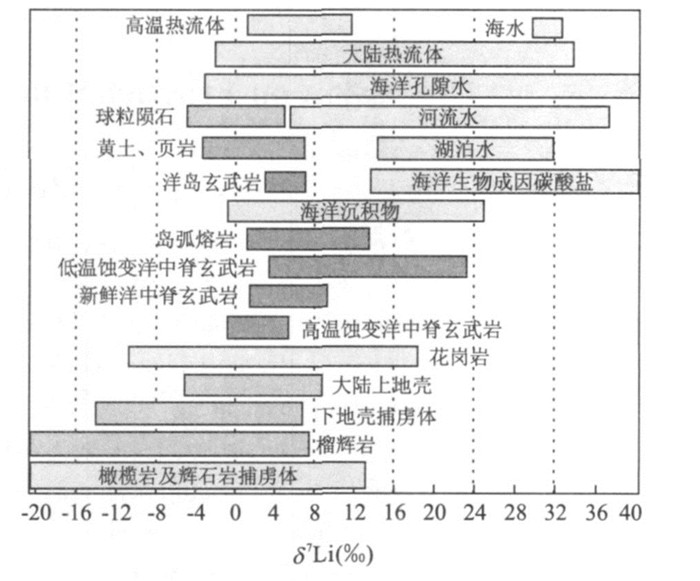
 下载:
下载:
